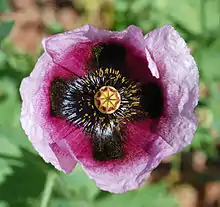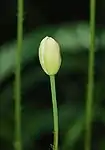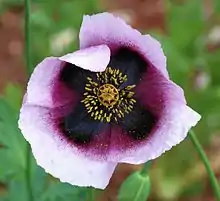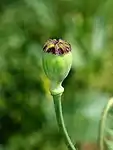Papaver setigerum
Papaver setigerum, common name poppy of Troy or dwarf breadseed poppy, is a herbaceous annual plant of the family Papaveraceae.
| Papaver setigerum | |
|---|---|
 | |
| Close-up on a flower of Papaver setigerum | |
| Scientific classification | |
| Kingdom: | Plantae |
| Clade: | Tracheophytes |
| Clade: | Angiosperms |
| Clade: | Eudicots |
| Order: | Ranunculales |
| Family: | Papaveraceae |
| Genus: | Papaver |
| Species: | P. setigerum |
| Binomial name | |
| Papaver setigerum DC. | |
| Synonyms | |
| |
This plant is closely related to and sometimes treated as a subspecies of opium poppy (Papaver somniferum). In fact it produces a very small amount of morphine alkaloids.[1] However, P. somniferum is diploid (n=11) and P. setigerum is tetraploid (n=22) with twice the number of chromosomes. So it cannot be considered the wild ancestral species of the opium poppy.[2]
Etymology
The genus name is derived from the Latin word papaverum meaning “poppy”, while the specific name setigerum derives the Latin "saetiger" meaning “bristly” for the short bristle on the top of the lobes of its leaves.[3]
Description
Papaver setigerum reaches on average 20–80 centimetres (7.9–31.5 in) in height.[3] The stem is erect and the leaves are simple, oblong, the lower ones are sessile, deeply lobed and toothed, the higher ones shortly pedunculated.
The flowers at the apex of the stem are hermaphroditic, actinomorphic ("star shaped", "radial"), 4 to 10 cm in diameter. The corolla forms a cup with four pink-purple petals, with a dark purple blotch at the base. It has several stamens with dark filaments holding yellow anthers. Flowering occurs from May through June.[3] The fruits are glabrous capsules 2 to 3 cm long, dehiscent along the holes located under the apical disc. The kidney-shaped seeds are about 1 mm wide.[4]
Distribution
This plant grows wild in the Mediterranean region, especially in southwestern Europe (Portugal, Spain, France, Italy, Greece) and in North Africa.[3][5]
Habitat
This plant grows in pastures and fields, at an average altitude of 0–600 metres (0–1,969 ft) above sea level.[3]
Gallery



 Papaver setigerum, plants with flowers in Aude, France
Papaver setigerum, plants with flowers in Aude, France Flower of Papaver setigerum, lateral view
Flower of Papaver setigerum, lateral view Flower of Papaver setigerum, inside view
Flower of Papaver setigerum, inside view Fruit of Papaver setigerum
Fruit of Papaver setigerum Leaf of Papaver setigerum
Leaf of Papaver setigerum
References
- La Valva, Vincenzo; Sabato, Sergio; Gigliano, Gesualdo Siniscalco (1985). "Morphology and Alkaloid Chemistry of Papaver setigerum DC. (Papaveraceae)". Taxon. 34 (2): 191–196. JSTOR 1221777.
- C. G. Farmilo, H. L. J. Rhodes, , H. R. L. Hart and, H. Taylor -Detection of Morphine in Papaver setigerum DC
- Pignatti S. - Flora d'Italia – Edagricole – 1982. Vol. I, pag. 353
- Acta Plantarum
- setigerum&PTRefFk=7500000 Euro+Med Plant Base
- Tutin, T.G. et al. - Flora Europaea, second edition - 1993
External links
| Wikimedia Commons has media related to Papaver setigerum. |
| Wikispecies has information related to Papaver setigerum. |